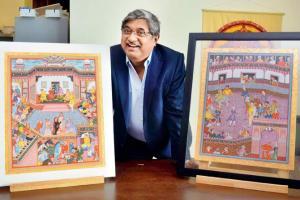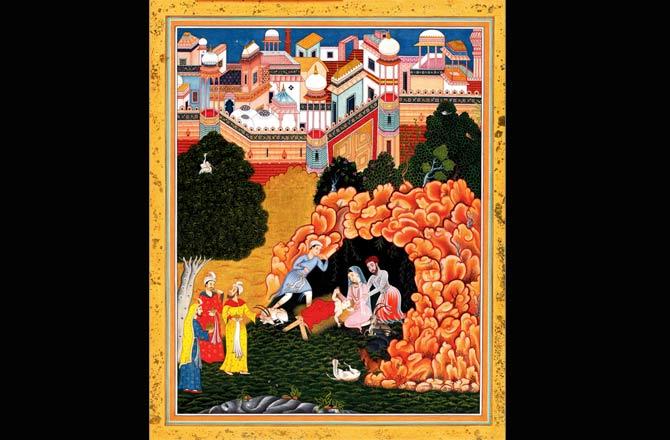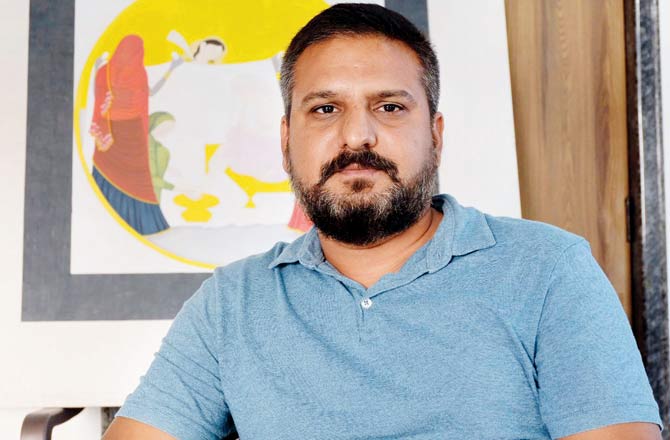What Akbar did 600 years ago, banker and collector Paul Abraham is doing today: footing the bill for an ambitious Indo-Persian miniature painting project

Paul Abraham with miniature paintings from the Isanama. PIC/Ashish Raje
This story begins the moment BC ended and AD started. The birth of Jesus Christ changed the world, so how could god's own country be far behind? Saint Thomas came to Kerala in AD 52, 19 years after the death of Christ. Three hundred years later, 72 families from Sanliurfa, present-day Turkey, followed him.
ADVERTISEMENT
Today, one of their descendants, the COO of IndusInd Bank, Paul Abraham has embarked on a legacy-making project: a series of miniature paintings depicting the life of Jesus Christ, but from an eastern perspective. "Christianity was an eastern religion," says Abraham. "It had its roots in present-day Israel-Palestine. It moved towards Turkey, Persia, Iraq. If it had prospered here, it would have probably been an Asian religion more than a European religion."

The Birth of Jesus Christ. Courtesy/Sarmaya Arts Foundation
Abraham has the deep knowledge of a professor, and the deep pockets of a banker. We meet him at a posh residence in Wadala East, the office of Sarmaya, an archive and library that houses his vast personal collection of coins, maps, photographs, tribal and modern artworks, and over 4,000 books. (He himself lives in Cuffe Parade.) A few years ago, he wanted to know: "Had Christianity thrived in the Middle East, what would the whole milieu have looked like? Even The Last Supper is basically [Leonardo] da Vinci's representation." So, Abraham got in touch with Manish Soni, a third-generation miniature painter from Bhilwara, Rajasthan.
"We discussed and chatted over a period of time to see if there was a tradition we could adopt." In 2016, they settled on the Hamzanama, a style of miniature painting whose history is quite the page-turner in Abraham's words. "One of the Muslim rulers, Mahmud of Ghazni [10th century], for his own entertainment, wrote stories about Prophet Muhammad's uncle, Hamza. Some were stories of valour, some were stories of humour. Then Akbar [16th century] decided he wanted to see the story in visual format, possibly because he couldn't read. So, he got his atelier of artists to interpret them.

Other Jesus' Manish Soni, miniature painter
It was a 14-year project, with hundreds of folios. From what I know, about 200 of those volumes survive in various museums of the world. It was an interesting technique [because] it combined Indian miniature traditions with Persian miniature traditions. For the first time, they increased the size of the portfolio. Normal miniature would be an A4; this was A3 or bigger in size." This was known as the Hamzanama. Taking another leaf out of Akbar's folio, Abraham is calling his project the Isanama. The Isanama is an ongoing series of 24 miniature paintings, half of which are ready, depicting key events in Christ's life.
"Jesus's life, from one to 12 years is known, then it disappears, and comes back at 30, and then he is crucified at 33," says Abraham. "In effect, we have only 15 years of life to represent." In Soni's rendering, Christ is surrounded by minarets, Rajasthani doors, Turkish tiles and Middle Eastern instruments. The men wear turbans and embroidered angarkhas; women wear cholis and skirts. When Christ turns wine into water at a wedding in Cana, the frame is overcrowded because "at no Asian wedding will you find only four people," says Abraham. Soni's Last Supper isn't a feast, but a quiet, sombre occasion with the 13 figures sitting around a fire. It's one of the rare frames in which details are shrouded in darkness. "His [Manish's] interpretation of The Last Supper is a bit Nainsukh," says Abraham, referring to the famous Pahari painter.
For Soni, this is a "dream come true" project. "I'm really fortunate that I have had the opportunity to do this," he tells us over the phone. "These days, patrons are not interested in Persian-style painting; they want commercial paintings like Pichwais." Soni is doing no personal research because "I only hear the stories from Paul's mouth. This is a commission and Paul is my patron. I want his Jesus in my painting; I don't want any other Jesus in the painting." Along with the artworks, the series is also recreating the relationship patrons and artists used to share in the time of Akbar.
"Royal patronage started to die out, [and] so did these guys," says Abraham. "Rich people need to provide patronage. If it takes him one-and-a-half months [to make one painting], how will he live? You have to compensate them for their livelihood and for their skill and stature." Soni's skill is evident right from the first painting he made for Abraham: the birth of Jesus Christ. In it, Mary is wearing a baby-pink choga and salwar, a transparent blue dupatta on her head, and strings of pearls around her neck. It looks like a queen has given birth, against the backdrop of Delhi.
Catch up on all the latest Mumbai news, crime news, current affairs, and also a complete guide on Mumbai from food to things to do and events across the city here. Also download the new mid-day Android and iOS apps to get latest updates
 Subscribe today by clicking the link and stay updated with the latest news!" Click here!
Subscribe today by clicking the link and stay updated with the latest news!" Click here!






